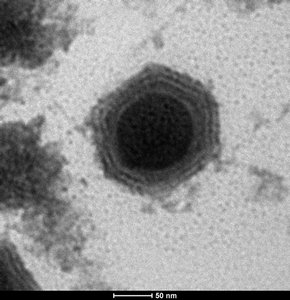Advertisement

 Emiliania huxleyi virus
Emiliania huxleyi virus
Picture taken with the help of Dr. Eyal Shimoni at the EM unit at Weizmann6
thJuly 2012
As promised, here is a little description of the wildlife we’ve encountered in the past few weeks, and we’ll start from the bottom up.
First and foremost, there are the algae and the virus. I know some of you might think “What? That’s wildlife??” but yes, to me it is. These organisms are just as amazing as any other, and the more we learn about them the more I’m struck by how sophisticated they are and how little we actually know about their intricate life cycle. The fact that you can’t see them with the naked eye just makes them all that bit more intriguing, and our job here that bit harder. Here is a picture of the virus I took back home at the electron microscopy unit at Weizmann. All it is, is some DNA wrapped in a few proteins and membranes, and still, the impact it has on the ocean and atmosphere is absolutely incredible.
Then there’s
Emiliania huxleyi (
http://www.soes.soton.ac.uk/staff/tt/). It comes from a great family of Coccolithophores, who are known for building intricate calcium carbonate scales that sink to the bottom of the ocean, and after many many years of piling
up, they can form land structures such as the Cliffs of Dover in England. I won’t go into the details of the life of
Emiliania, but if you’re interested, just google it.
Next on the list are the little itty bitty things that get caught in out traps and samplers. The most abundant must be the Copepods. Copepods are tiny little grazers that look a little like bugs; they will eat just about anything out there, including the algae we’re looking so hard for. We also get a lot of Pteropods (
http://en.wikipedia.org/wiki/Pteropoda), small, snail-like creatures that are quiet beautiful to look at under the dissecting scope (and you can eat them, they’re salty and crunchy, a great snack!).
A few days ago one of the crew came in with a bucket full of small shrimp that got caught in one of the engines water cooler intakes. We had to look at them a little closer, just to discover that a shrimp is a shrimp, whether on your plate or in the engine. It took me hours to get the smell off my hands…
Then Anton found a flying fish in one of the nets. It probably isn’t
from this neck of the woods, but most likely flew into the net during one of Knorrs previous journeys and was only found now.
Take a look at the Portuguese Man of War that floated by a while ago. At the beginning it looked like a plastic bag, but when it got closer we could see how amazingly beautiful it is.
To me it was a surprise to see so many birds out here, in the middle of nowhere. The most common is the Northern Fulmar; we’ve a whole bunch of them following us for a good few weeks now. What are they doing here, you may ask. Well, I don’t know. Probably just hanging out, waiting for the remains of lunch to be tossed overboard. We also saw what looked like a Northern Gannet, but he just popped in to say hello and flew off. We think there was a third type of bird flying about, but didn’t get the chance to see details and identify it.
Whales!! I blogged previously about the pod of Pilot whales we saw way back in the first week of this cruise. Since then we’ve seen many more of them.

 Portuguese Man of War
Portuguese Man of War
Looks like a jellyfish, but it actually isn't a jellyfishEvery few days we get a visit from the Pilots. I think they’re arranging sightseeing tours to see the humans on the floating tin can. Yesterday a whole pod came very close to the ship; they were probably no more than 200 meters away, jumping and playing around for about 15 minutes, then they just swam away. Definitely the best show in town.
Last but not least – the big whales. We’ve seen some Humpback whales, but sadly they haven’t had the courage to come too close. We even got a glimpse of some breaching, but it was so far away we needed binoculars to see. Still, it made me very happy.
All this waiting for creatures to appear means that everyone has a camera on hand. Wherever you go, whatever you do, there’s someone right there taking a picture. And I’m not a fan of the camera, unless I’m the one doing the shooting, but I did get my picture taken a few times. This is my favorite one.
Think sustainability, save our magnificent blue marble!
Daniella
Advertisement
Tot: 0.063s; Tpl: 0.011s; cc: 6; qc: 24; dbt: 0.0275s; 1; m:domysql w:travelblog (10.17.0.13); sld: 1;
; mem: 1mb



 Emiliania huxleyi virus
Emiliania huxleyi virus
 Portuguese Man of War
Portuguese Man of War





Robbie Siben
non-member comment
Interesting information. I like the photos. Keep workin!